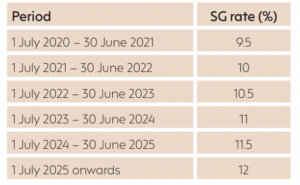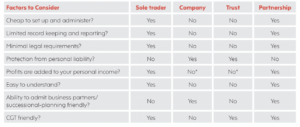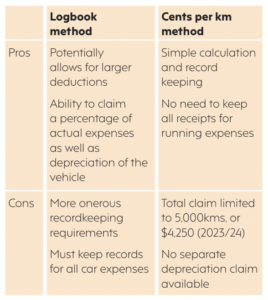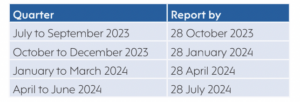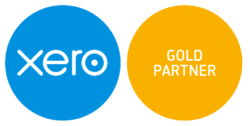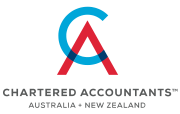Thought of registering a trademark for your new business?
The ATO has issued a reminder around trademarks!
For background, a trademark legally protects your brand and helps customers distinguish your products or services in the market from others. Trademarks can be used to protect a logo, phrase, word, letter, colour, sound, smell, picture, movement, aspect of packaging or any combination of these. In short, they protect your brand, products and services.
Trademarks are different from a business name which is the name you trade under.
For exclusive rights to your business name, you’ll need to protect it with a trademark. This will help you:
■ protect your name and stop others from trading with it
■ get exclusive use of that trademark throughout Australia
■ have protection in all Australian states and territories for an initial period of ten years.
Trademarks are intellectual property. Other types of intellectual property include:
■ patents
■ design rights
■ plant breeder’s rights
■ copyright
■ trade secrets.
While you don’t need a registered trademark to apply for an ABN, registering a trademark for your business name, logo, or other sign means you have exclusive rights to use your trademark in Australia.
■ A registered trademark is a licensable and saleable asset. It also provides a legal avenue to stop others from using it on similar goods and services. A 5-minute check can help save you a lot of disappointment and work.
■ Check out IP Australia for more information and get your trademark sorted today.
■ The same ATO release, reminds taxpayers of the business registrations and insurances that may be required for your new business.
As a new business, you may also need to:
■ register for goods and services tax (GST)
■ register for pay as you go (PAYG) withholding and meet your super obligations for any employees you hire
■ register for fringe benefits tax (FBT) when you are providing fringe benefits to your employees.
You can apply for an ABN and other key business registrations through the Business Registration Service.
You may also need business insurance and licences to protect your business. It’s important to understand the licences and permits you need to do certain activities and help protect your business and employees.
Self-education: when is it deductible?
If the subject of self-education leads to, or is likely to lead to, an increase in the taxpayer’s income from current (but not new) income-earning activities, a deduction for self-education expenses incurred will be allowable.
There is no specific provision in the income tax legislation that allows a deduction for self-education expenses. Rather the expenditure falls for consideration under the general deductibility provision of the Tax Act. In broad terms this allows for, but also limits, deductible expenses to those incurred in the course of earning assessable income. This requires a close nexus between the outgoing and assessable income: the outgoing must be incidental and relevant to the gaining of the assessable income.
Principle 1 – the self-education maintains or improves current skills or knowledge
Where a taxpayer’s income-earning activities are based on the exercise of a skill or some specific knowledge, a deduction for self education expenses incurred will be allowable where the subject of self-education enables the taxpayer to maintain or improve that skill or knowledge. The High Court decision of FC of T v Finn [1961] HCA 61; 106 CLR 60 is a leading authority for this principle. In this case, Finn, a senior government architect, was allowed deductions for expenses incurred on an overseas tour focused on the study of architecture.
This principle requires an assessment of a taxpayer’s current skills and knowledge compared against the subject of self-education, and a consideration of how close the subject is to those current (not future) income-earning activities. (The ATO advises the relevant employment activities are the duties and tasks expected of an employee to perform their job and are usually set out in an employee’s duty statement / contract of employment.)
Principle 2 – the self-education leads to, or is likely to lead to, an increase in income from current income-earning activities
If the subject of self-education leads to, or is likely to lead to, an increase in the taxpayer’s income from current (but not new) income-earning activities, a deduction for self-education expenses incurred will be allowable.
It is not necessary for the expected increase in income or promotion to be realised for self-education expenses to be deductible, for example, if the taxpayer’s employment was terminated before gaining the promotion or increase. However, the expenses should be incurred whilst the taxpayer was employed (even if on leave without pay), and generally with a real prospect or likelihood of leading to such an increase or promotion.
The important thing for taxpayers is to retain their receipts in relation to their self-education. If you have any questions around what expenses are claimable, contact us.
Avoid schemes targeting SMSFs
Sometimes promoters of schemes target self-managed super funds (SMSFs). Schemes can include tax avoidance arrangements that inappropriately channel money or assets into your SMSF so you pay less tax. They may also include arrangements promoting the illegal early release of benefits from your fund for personal use.
To assist you with identifying schemes that may jeopardise your SMSF’s compliance, the ATO recently updated its web content to provide more information:
■ Schemes targeting SMSFs
■ Residential property purchased through illegal schemes.
Remember, if:
■ You’ve been approached by a someone who recommends you set up an SMSF or use your existing SMSF to participate in one of these schemes or a similar arrangement, you should check the ASIC Financial Register to make sure they have a financial licence. If you’re in doubt, you should seek a second opinion from a licenced adviser who is independent from the scheme.
■ You’re already dealing with a suspected promoter of an SMSF scheme, then you should contact the ATO immediately so they can help.
CAUTION!
Don’t be tempted by ‘too good to be true’ schemes. You may risk losing some or all of your retirement savings and receive significant penalties if you enter into one of these schemes. You could also be disqualified as a trustee of your SMSF and may be required to wind up your fund.
Discounting your capital gain
The capital gains tax (CGT) discount can reduce by 50% a capital gain that you make when you dispose of (sell) a CGT asset that you have owned for 12 months or more. However, the discount is only available to:
■ individuals (but not foreign or temporary residents)
■ complying superannuation funds (33% discount applies, not 50%)
■ trusts, and
■ life insurance companies in respect of a discount capital gain from a CGT event in respect of a CGT asset that is a complying superannuation asset.
The most notable omission from this list is companies. They are not eligible for the general discount. This should be factored in when assessing which entity is chosen to acquire a CGT asset.
12-month requirement
The tax legislation requires that to qualify for the general discount, the asset must have been acquired at least 12-months before the time of the CGT event (sale).
The 12-month period requires that 365 days (or 366 in a leap year) must pass between the day the CGT asset was acquired and the day on which the CGT event happens…effectively 12-months and two days! If a taxpayer is nearing the 12-month mark, they should consider delaying the sale where possible until this timeframe is satisfied and therefore becomes eligible for the discount.
For the purposes of satisfying the 12-month holding period, beneficiaries can treat an inherited asset as though they have owned it since:
■ the deceased acquired the asset, if they acquired it on or after 20 September 1985
■ the deceased died, if they acquired the asset before 20 September 1985.
Note more generally that for CGT assets acquired before 20 September 1985, no CGT is payable anyway.
Foreign residents
The CGT discount no longer applies to discount capital gains of foreign or temporary residents or Australian residents who have a period of foreign residency after the below date. However, the CGT discount will still apply to the portion of the discount capital gain of a foreign resident individual that accrued up until 8 May 2012 (the date of announcement).
This measure applies where:
■ an individual has a discount capital gain, including a discount capital gain as a result of being a beneficiary of a trust, from a CGT event that occurred after 8 May 2012, and
■ the individual was a foreign resident or a temporary resident at any time on or after 8 May 2012.
The effect of the measure is to:
■ retain the full CGT discount for discount capital gains of foreign resident individuals to the extent the increase in value of the CGT asset occurred prior to 9 May 2012
■ remove the CGT discount for discount capital gains of foreign and temporary resident individuals accrued after 8 May 2012, and
■ apportion the CGT discount for discount capital gains where an individual has been an Australian resident, and a foreign or temporary resident, during the period after 8 May 2012. The discount percentage is apportioned to ensure the full 50% discount percentage is applied to periods where the individual was an Australian resident.
If you have any questions about the 50% discount, please contact us.
Appointing an SMSF auditor
Early last month, the ATO issued a reminder around auditors. If you have an SMSF, you need to appoint an approved SMSF auditor for each income year, no later than 45 days before you need to lodge your SMSF annual return (SAR).
Your SMSF’s audit must be finalised before you lodge, as you’ll need some information from the audit report to complete the SAR. You must ensure the correct auditor details are provided in the SAR, otherwise you may be penalised.
Your auditor will perform a financial and compliance audit of your SMSF’s operations before lodging.
Remember, an audit is required even if no contributions or payments are made in the financial year.
Your approved SMSF auditor must be:
■ registered with the Australian Securities and Investment Commissioner – and you’ll need to provide their SMSF auditor number on your SAR
■ independent – auditors shouldn’t audit a fund where they:
• hold any financial interest in the fund, or where they have a close personal or business relationship with members or trustees
• work for a firm which provides your fund with other services such as certain accounting services, tax, super or financial planning advice.
If a fund doesn’t meet the rules for operating an SMSF, the auditor may be required to report any contraventions to the ATO.
Approved SMSF auditors can be busy so it’s a good idea to start this process early when the time comes around.
You can find a list of approved SMSF auditors on the ASIC website.
Costs of a caravan/motor home for work-related travel
SCENARIO
I run a small business that requires me to travel quite a lot, particularly to country areas where I will often stay overnight. To save on accommodation costs, I have purchased a caravan. I have a business logo on the side of the caravan that is on display when I attend town shows and events. Will the costs of purchasing and maintaining my caravan be deductible in my individual income tax return?
GUIDANCE
In these challenging and changing times, many have jumped on the modern version of the proverbial band wagon and purchased a caravan or motor home to use for work or business-related travel.
It is a common misconception that specific rules govern whether you can claim a tax deduction for the costs of purchasing and maintaining a caravan or motor home. A caravan or motor home is no different to any other work or business asset you own, and the extent the expenses are deductible will depend upon the extent you use the caravan or motor home for income producing purposes. The complexity does not arise because the expenses relate to a caravan or motor home, but that the expenses (in our scenario above) are essentially travel and accommodation expenses, and this is an area of tax law that can be difficult to apply in practice.
Travel and accommodation expenses are deductible under the tax legislation where you incur these expenses gaining or producing assessable income, or they are necessarily incurred in carrying on your business.
Travel between two unrelated work locations is also deductible where neither of the two work locations is your home (although in this case, the costs may still be deductible under the general deduction provision).
Travel costs will not be deductible if they are a prerequisite to earning income, if you are living away home (rather than travelling on work) nor if they are as a result of your own personal choice or circumstances, eg, the costs are not deductible just because you decide it is more convenient to stay overnight. It would seem that if it is reasonable that you would stay overnight rather than travelling to and from a location within a day, and the reason cannot be attributed to a personal choice, then it is more likely the travel would be viewed as work-related.
Keeping a diary would help support your deduction (and is necessary as a sole trader travelling for six or more consecutive nights).
Generally, the depreciation and GST claim on a caravan or motorhome is not limited by the car limit (currently $68,108) because a caravan or motorhome (designed to carry a load of more than one tonne) is not a ‘car’ as defined in the tax legislation.
What if my business logo is on my caravan?
The good news is while the cost of the business logo will ordinarily be tax deductible as advertising, the bad news is the ATO is firmly of the view that placing a business logo on the side of a caravan (or any type of motor vehicle) will not turn private travel into business travel, even if the signage is affixed permanently. This means if the travel expenses are not tax deductible without a logo, the travel expenses will not be deductible with a logo.
Click to view Glance Consultant’s September 2023 newsletter via PDF




